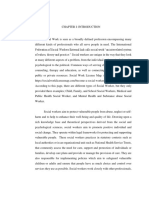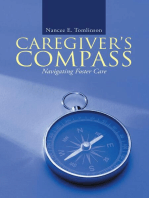Com Prob
Com Prob
Uploaded by
api-302521162Copyright:
Available Formats
Com Prob
Com Prob
Uploaded by
api-302521162Original Title
Copyright
Available Formats
Share this document
Did you find this document useful?
Is this content inappropriate?
Copyright:
Available Formats
Com Prob
Com Prob
Uploaded by
api-302521162Copyright:
Available Formats
1
Running Head: Community Problem
Veronica Mendoza
University of Texas at El Paso
Abstract
Running Head: Community Problem
The security and safety of the children in the United States relies a lot on child welfare workers.
Child welfare workers insure and protect children from being physically, emotionally and
mentally abused or neglected. There are many steps child welfare workers have to take in order
to remove a child from their biological parents. As well as the process of putting them in foster
care homes. Many parents dealing with child protective services dont understand the power
child welfare have and what rights the parents have. It is a vital factor that all parents should
know and understand thoroughly.
Running Head: Community Problem
The job of a CPS worker is to insure the safety of the child and make sure he isnt being
neglected. They are responsible of identifying and documenting abuse and finding the
appropriate solutions to enhance the childs well being. They should also must be able to identify
the problem or threat immediately and be able to provide the appropriate services for the child.
Some of these might include, placing the child in foster care, counseling for both the child and
the parents or finding a home for children that have no guardian. The safety of the kids in the U.S
relies on CPS workers.
Research should analyze areas with these following questions:
1. What are the factors that affect foster care placement in children receiving child
protective services?
2. What do cps workers do in order to ensure the safety of the children?
3. What is child negligence?
4. What is the central role of foster parents?
What Is Child Welfare Services?
Many people in the U.S dont know what child welfare services are. Some might know what they
are but not fully. Child Welfare Services is a branch of government that protect children from
Running Head: Community Problem
abuse and/or neglect. Child welfare systems investigate reports of children that might possibly be
abused or neglected. Many hospitals and schools are the ones that contact CPS. CPS receives
the reports and conducts investigations and assessments and provide interventions to the families
in order to ensure safety. The child welfare system provides services to families that are in need
of assistance in the care and protection of their children. They might remove the children from
their parents and place them in foster homes in the process. The public welfare system functions
at a federal, state, and all local levels. The child welfare system varies depending on the states
laws and regulations. Once a report of suspected child abuse or neglect is received by the
Family & Childrens Services Hotline, it is evaluated using an evidence-based assessment known
as Structured Decision Making (SDM), which helps to guide toward the most appropriate
response. If it is determined that an in-person response must be made by an Emergency Response
(ER) social worker, the worker will assess further involvement by Family & Childrens Services
through one of three response paths. This family-centered, community-based approach is
known as the Differential Response model.
What are the factors that affect foster care placement in children receiving child protective
services?
The decision of CPS is all driven by one objective, to ensure the protection of the children and
Running Head: Community Problem
prevent any further maltreatment. One of the best options child welfare workers take in order to
ensure the safety of the children is placing them in substitute care. The foster parents where the
children are placed sometimes never receive money to support the kids and sometimes. One
might think that they have some sort of guide that the caseworkers and judges take in order to
make a decision but they dont. They work without guidelines and their decisions become
unreliable, every case is subject to individual basis and idiosyncratic factors. Theabsenceof
standardplacementcriteriaisnotbecauseofalackofconcern.Clinicalmodelshave
focusedonidentifyingcriteriathatshouldbeconsideredwhenmakingaplacement
decision.Althoughnotallmodelsidentifythesamestandards,criteriacanbeorganized
intosixdomains:child,parent,family,environment,maltreatment,andintervention
(Zuravin, S., & Depanfilis, D. 1997). This is one of the biggest factors that intervene with the
placement of children into permanent or temporary and one of the most important ones. This
means that the judges and caseworkers only do it based off of what they believe is right. They
have come up with models to identify and that should be considered while making a placement
decision, but its still not enough.
Whatischildnegligence?
Child neglect is one of the most common forms of child maltreatment. Approximately 899,000
children in the United States are a victims of neglect. There are different types of neglect. The
first one is physical neglect, which involves the parent or caregiver not providing the basic needs
Running Head: Community Problem
and necessities. For example, clothing, shelter, and food. The failure to provide these necessities
endangers the childs physical health and well being and growth and development. Physical
neglect also incudes inadequate supervision and abandonment of the child. Physical neglect can
really impact a childs development and well being. Another type of physical neglect is serious
physical harm like cuts, bruises, burns or any other injuries due to the lack of supervision. The
second type of neglect is emotional and psychological neglect which is the allowing a child to
use drugs or alcohol and by showing no affection. The third one educational neglect which is the
failure of the parent or caregiver to enroll the child in school or appropriate home schooling. And
the last one is medical neglect which is failure to provide the right health care for the child.
WhatisthemainorcentralroleofFosterparents?
Dealingwithkidsthataregoingthroughahardtimeintheirlifeisprobablyahardjobtodo.
Whatchildlikestobetakenawayfromtheirparentandbeplacedinahousewhereyoudont
knowanyone.Mostofthesekidsarelittleandundertheageof18.Everylittlekidneedtheir
Running Head: Community Problem
parents,thatswhyitsveryhardforfosterparents.Therearealotofkidsthatundergoalotof
maltreatment.Thisarticlementions Many children enter foster care suffering from insufficient
prenatal and health care, poverty, homelessness, exposure to alcohol and other drugs, learning
problems in school, and, of course, physical abuse, sexual abuse, and neglect. Whentheyenter
fostercaretheyenterwithspecialhealthandmentalhealthneeds.ThearticlementionsTheir
role in improving child well being is explained and recommendations for policy, practice and
advocacy also are included. Foster parents have a policy and they have to follow all the
recommendations given by the welfare workers and judges. They are given steps to follow and
are given correct help in order to be the best for the children
Child welfare workers have a lot of work and investigation. Large amounts of kids are in trouble
and it is the job of CPS worker to intervene and help. Child welfare workers are always needed
thats why they are a branch of government. There are many different aspects of this job that
make it very stressful and difficult but they will always be needed. My recommendation would
be to further your studies in this profession. Helping children and saving their lives. There were a
lot of children that are being abused and neglected and we should be there to help.
References
(n.d.). Retrieved November 9, 2016, from https://www.childwelfare.gov/pubpdfs/cpswork.pdf
Running Head: Community Problem
Zuravin, S., & Depanfilis, D. (1997). Factors affecting foster care placement of children receiving child protective services. Social Work
Research, 34-42. Retrieved from http://swr.oxfordjournals.org/content/21/1/34.full.pdf+html
Goldstein, J., & Freud, A. (1973). Beyond the best interests of the child (Vol. 1). New York:Free Press.
Retrieved from: https://books.google.com/books?hl=en&lr=&id=n7qqXaBxk8wC&oi=fnd&pg=PR9&d
=1.%09What+are+the+steps+in+order+to+place+a+child+in+foster+care&ots=ak1LHvU
ySN&sig=eJzNEY97IQAOrqKS4WMk78CzCrw#v=onepage&q&f=false
Pasztor, E., Hollinger, D., Inkelas, M., & Halfon, N. (2006). Health and mental health services for children in foster care: The central
role of foster parents. Retrieved November 14, 2016, from
https://www.aap.org/en-us/advocacy-and-policy/aap-healthinitiatives/healthy-foster careamerica/Documents/Health_and_
Mental_Health_Foster_Parents.pdf
You might also like
- Optimizing DAX ResourceDocument8 pagesOptimizing DAX ResourceYeyejNo ratings yet
- Risk and Risk MeasurementDocument18 pagesRisk and Risk MeasurementEzekiel Ogaga OvbioghorNo ratings yet
- Formal Analysis Paper 2Document9 pagesFormal Analysis Paper 2api-727646816No ratings yet
- Final Draft - LmartinezDocument5 pagesFinal Draft - Lmartinezapi-403389159No ratings yet
- Law 345Document12 pagesLaw 345Khaled RehmanNo ratings yet
- Cert 111 Children ServicesDocument85 pagesCert 111 Children ServicesMasood Amin75% (4)
- Child Welfare Group Care Literature ReviewDocument4 pagesChild Welfare Group Care Literature Reviewrpmvtcrif100% (1)
- Ahs8100 AgencyprofileDocument10 pagesAhs8100 Agencyprofileapi-277510691No ratings yet
- Family Child WelfareDocument49 pagesFamily Child WelfareNilesh JugadooNo ratings yet
- APA Guidelines For Psychological Evaluations in Child Protection MattersDocument12 pagesAPA Guidelines For Psychological Evaluations in Child Protection MattersFrancisco EstradaNo ratings yet
- Child Care Essay U3 - Fhs 1500Document3 pagesChild Care Essay U3 - Fhs 1500api-314526511No ratings yet
- AMC Report and Recommendations On CFS - "Bringing Our Children Home"Document17 pagesAMC Report and Recommendations On CFS - "Bringing Our Children Home"MelEverette100% (1)
- Overmedicating Our ChildrenDocument7 pagesOvermedicating Our ChildrenpaynegallimoNo ratings yet
- Social Policy Analysis Final 002Document14 pagesSocial Policy Analysis Final 002api-727613303No ratings yet
- Child Abuse Prevention Manual-4 PDFDocument68 pagesChild Abuse Prevention Manual-4 PDFThủy LýNo ratings yet
- State Policies Addressing Child Abuse and Neglect - National Conference of State Legislatures (2015)Document8 pagesState Policies Addressing Child Abuse and Neglect - National Conference of State Legislatures (2015)Omar Rodriguez OrtizNo ratings yet
- Nursing Ethics in The Care of Infants andDocument37 pagesNursing Ethics in The Care of Infants andapi-338453738No ratings yet
- Child AbuseDocument33 pagesChild AbuseScribdTranslationsNo ratings yet
- Child Protection Interview Summery TeamDocument4 pagesChild Protection Interview Summery Teamawatson512_192260914No ratings yet
- Ethical Dilemma Summary - BolinDocument3 pagesEthical Dilemma Summary - Bolinapi-432368283No ratings yet
- Final PaperDocument8 pagesFinal PaperbcurrancctNo ratings yet
- Professional Issue in Early Childhood Education - EditedDocument8 pagesProfessional Issue in Early Childhood Education - Editedsaleem razaNo ratings yet
- Foster Care in IndiaDocument4 pagesFoster Care in IndiaLilly SinghNo ratings yet
- Child Abuse Lit ReviewDocument8 pagesChild Abuse Lit Reviewapi-254441697No ratings yet
- Intervention AssignmentDocument14 pagesIntervention Assignmentapi-654150428No ratings yet
- Child Maltreatment Prevention Programs Research PaperDocument14 pagesChild Maltreatment Prevention Programs Research Paperapi-349307498No ratings yet
- Child Abuse - 20231009 - 222440 - 0000Document13 pagesChild Abuse - 20231009 - 222440 - 0000scinicshahahaNo ratings yet
- SW 3710Document19 pagesSW 3710api-250788843No ratings yet
- Child Sexual Abuse - Intervention and Treatment IssuesDocument132 pagesChild Sexual Abuse - Intervention and Treatment Issuesbellydanceafrica9540No ratings yet
- Final Paper EngDocument6 pagesFinal Paper Engapi-373752274No ratings yet
- Child Protection Policy - Edited.editedDocument11 pagesChild Protection Policy - Edited.editedmaria luisa radaNo ratings yet
- Edna Research Physical Abuse. Chapter 1 To 5Document63 pagesEdna Research Physical Abuse. Chapter 1 To 5mutanolynnNo ratings yet
- Beyond Quick Fixes: What Will It Really Take To Improve Child Welfare in America?Document10 pagesBeyond Quick Fixes: What Will It Really Take To Improve Child Welfare in America?Public Consulting GroupNo ratings yet
- Psychology PaperDocument1 pagePsychology Paperapi-241000017No ratings yet
- Call For IdeasDocument467 pagesCall For IdeasNeil ShellardNo ratings yet
- Michigan Child Care MattersDocument20 pagesMichigan Child Care MattersMichigan NewsNo ratings yet
- 4810 - Paper 1Document8 pages4810 - Paper 1api-250287562No ratings yet
- TTOTW Practice Parameter Child Welfare System The Chat With DR DaveDocument6 pagesTTOTW Practice Parameter Child Welfare System The Chat With DR DaveDavid P SanchezNo ratings yet
- Child Abuse PresentationDocument22 pagesChild Abuse PresentationMega100% (1)
- Researched Argument Final Draft 2Document7 pagesResearched Argument Final Draft 2api-741567530No ratings yet
- CM Factsheet ADocument2 pagesCM Factsheet ARebecca RichardsonNo ratings yet
- Child AbuseDocument6 pagesChild AbuseIshanviNo ratings yet
- Manifested in Any Forms. These Includes, But Is Not Limited To Bruises, Welts, Cigarette BurnsDocument11 pagesManifested in Any Forms. These Includes, But Is Not Limited To Bruises, Welts, Cigarette BurnsMacxyFernandezNo ratings yet
- Intervention Effectiveness For Children and Youth (Whitney&Hilston, 2013)Document6 pagesIntervention Effectiveness For Children and Youth (Whitney&Hilston, 2013)YtsircNo ratings yet
- Book 3 Children With Multiple Disabilities Manual PDFDocument42 pagesBook 3 Children With Multiple Disabilities Manual PDFSola Naberra AchilleaNo ratings yet
- DCWCChild Welfare DefinedDocument4 pagesDCWCChild Welfare Definedangel Au YeungNo ratings yet
- CpsworkDocument9 pagesCpsworkapi-310517163No ratings yet
- Diass ReportDocument3 pagesDiass ReportKristine M. MosqueraNo ratings yet
- Investigation On Child Abuse - FINAL WORKDocument35 pagesInvestigation On Child Abuse - FINAL WORKScribdTranslationsNo ratings yet
- Child Abuse and Its ImpactsDocument22 pagesChild Abuse and Its ImpactsUmaima MalikNo ratings yet
- Chapter 1 - 5 Updated To Past TenseDocument81 pagesChapter 1 - 5 Updated To Past TenseDiana Laura Lei100% (2)
- Treatment For Abused and Neglected Children: Infancy To Age 18Document127 pagesTreatment For Abused and Neglected Children: Infancy To Age 18Jasmina Nina MihojevićNo ratings yet
- Social Work Creative WritingDocument8 pagesSocial Work Creative WritingRenz AntonioNo ratings yet
- Research PaperDocument8 pagesResearch Paperapi-236630264No ratings yet
- Child Development Module 11Document5 pagesChild Development Module 11Emily ReanNo ratings yet
- Human RightsDocument5 pagesHuman Rightsapi-495193458No ratings yet
- What To Do About Deadbeat Parents PersuasiveDocument4 pagesWhat To Do About Deadbeat Parents PersuasiveNgô CẩuNo ratings yet
- Andreea Safeguarding Assignment 2022 123468 3 ULTIMULDocument15 pagesAndreea Safeguarding Assignment 2022 123468 3 ULTIMUL1010043andreeaNo ratings yet
- Disciplining Someone Else’S Children: A Guide for Child Care ProvidersFrom EverandDisciplining Someone Else’S Children: A Guide for Child Care ProvidersNo ratings yet
- DTE MicroprojectDocument22 pagesDTE MicroprojectShreyas Bagate100% (1)
- 11th Physics Practical 1Document8 pages11th Physics Practical 1YashNo ratings yet
- EIGRP Troubleshooting: Cisco CCNP ROUTE TrainingDocument12 pagesEIGRP Troubleshooting: Cisco CCNP ROUTE TrainingjosephjoNo ratings yet
- Backflush CostingDocument45 pagesBackflush CostingKIROJOHNo ratings yet
- Grading of Wool-1Document18 pagesGrading of Wool-1Nitesh DhakaNo ratings yet
- Invigilator Roles and ResponsibilitiesDocument38 pagesInvigilator Roles and ResponsibilitiesAsif Yaqub Khan100% (1)
- 7.modeling BaseflowDocument4 pages7.modeling Baseflowsugendengal100% (1)
- Yeast and Mold Spoilage in Dairy ProductsDocument4 pagesYeast and Mold Spoilage in Dairy ProductsAngelica Alejandra De La Torre AnayaNo ratings yet
- Maths PDFDocument4 pagesMaths PDFrthirupaNo ratings yet
- Discrete MathematicsDocument23 pagesDiscrete MathematicsccchengchuuuNo ratings yet
- PB 211Document17 pagesPB 211Jhuli Elizabeth CNo ratings yet
- The Launch of The EuroDocument13 pagesThe Launch of The Euromai.hnx4205No ratings yet
- A Guide To Tactical Appreciation 1987Document112 pagesA Guide To Tactical Appreciation 1987Andrea DiazNo ratings yet
- Documentatie MobilpayDocument12 pagesDocumentatie MobilpayMihai IsvoranuNo ratings yet
- Applied Strongman Training Part 2Document48 pagesApplied Strongman Training Part 2shaft181100% (2)
- Rhetorical Analysis ArticleDocument6 pagesRhetorical Analysis Articleapi-242472728No ratings yet
- Proposed Weekly Hebrew Study RoutineDocument2 pagesProposed Weekly Hebrew Study RoutineClaytonNo ratings yet
- Dux Scaler Spec Sheet - Fix Cab PDFDocument2 pagesDux Scaler Spec Sheet - Fix Cab PDFvivalpsNo ratings yet
- Muzaffar Hayat: Educational AttainmentDocument5 pagesMuzaffar Hayat: Educational AttainmentJairo WilchesNo ratings yet
- NEG3MathPTPaper 12 06 10Document6 pagesNEG3MathPTPaper 12 06 10Mary Lou m. VelezNo ratings yet
- Step 1: Designing Manufacturing Training ProgramsDocument37 pagesStep 1: Designing Manufacturing Training Programsjaikrishna gangala100% (1)
- 25th Dhil-Hajj Abu Al Moghith Al Husain Ibn Mansur Al Hallaj RadiAllahAnhoDocument7 pages25th Dhil-Hajj Abu Al Moghith Al Husain Ibn Mansur Al Hallaj RadiAllahAnhoHussain AliNo ratings yet
- Viet em Tieng AnhDocument50 pagesViet em Tieng AnhPham Ba DatNo ratings yet
- Redox Flow Battery PDFDocument9 pagesRedox Flow Battery PDFpedro_cabezas_2No ratings yet
- TKT Clil HandbookDocument30 pagesTKT Clil HandbookWawa ChenNo ratings yet
- Ficha Tecnica Cacao PolvoDocument2 pagesFicha Tecnica Cacao PolvofernandagbNo ratings yet
- Mack MP7, MP8, MP10 Engines Overhaul Part Numbers Reference Guide Vol 16013B MACKDocument2 pagesMack MP7, MP8, MP10 Engines Overhaul Part Numbers Reference Guide Vol 16013B MACKviemey1952100% (2)
- Kinetics - The Maxwell-Boltzmann Distribution and Catalysts (A-Level Chemistry) - Study MindDocument25 pagesKinetics - The Maxwell-Boltzmann Distribution and Catalysts (A-Level Chemistry) - Study MindkeysNo ratings yet

























































































